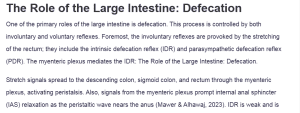The Role of the Large Intestine: Defecation
One of the primary roles of the large intestine is defecation. This process is controlled by both involuntary and voluntary reflexes. Foremost, the involuntary reflexes are provoked by the stretching of the rectum; they include the intrinsic defecation reflex (IDR) and parasympathetic defecation reflex (PDR). The myenteric plexus mediates the IDR: The Role of the Large Intestine: Defecation.
Stretch signals spread to the descending colon, sigmoid colon, and rectum through the myenteric plexus, activating peristalsis. Also, signals from the myenteric plexus prompt internal anal sphincter (IAS) relaxation as the peristaltic wave nears the anus (Mawer & Alhawaj, 2023). IDR is weak and is thus aided by the PDR, which is mediated by the spinal cord. Here, the spinal cord transmits motor signals that intensify peristaltic action in the descending colon, sigmoid colon, and rectum and trigger IAS relaxation (Saladin, 2021).
At the external anal sphincter (EAS), defecation is controlled voluntarily. The puborectalis muscle also aids in voluntary delayed defecation. This muscle coils around the rectum, creating a sharp anorectal angle that prevents feces from passing. Nonetheless, defecation occurs after voluntary relaxation of the puborectalis muscle and EAS (Saladin, 2021).
In this case, the rectum becomes straight, which is followed by the opening of the EAS for feces to move out. It is also worth noting that defecation is aided by a voluntary mechanism called the Valsalva maneuver. In this process, one increases abdominal pressure by holding their breath and contracting the abdominal muscles, thereby contracting the rectum and pushing the feces out (Saladin, 2021).
Conclusively, defecation is facilitated by the coordination of the gastrointestinal, nervous, and musculoskeletal systems. The process begins with the stretching of the rectum, which initiates defecation reflexes that are coordinated by the nervous system. These reflexes involve rectal muscle contraction and relaxation of the IAS (involuntary) and EAS (voluntary).
These structures contain different cells and tissues that aid in the defecation process. The rectum is layered by columnar epithelial cells that become nonkeratinized stratified squamous epithelium, IAS contains smooth muscle cells, and EAS has striated skeletal muscle tissue. Also, goblet cells secrete mucus to lubricate the intestinal wall and ease the defecation process.
References
Mawer, S., & Alhawaj, A. F. (2023, November 13). Physiology, defecation. StatPearls – NCBI Bookshelf. https://www.ncbi.nlm.nih.gov/books/NBK539732/
Saladin, K. (2021). Anatomy and physiology: The unity of form and function (9th ed.). McGraw-Hill Education.
ORDER A PLAGIARISM-FREE PAPER HERE
We’ll write everything from scratch
Question
Initial Post Instructions
- There are a variety of roles that occur within the large intestines. In this first posting, please focus on one of the roles of the large intestines, explain it, describe the cells that help accomplish this role, and identify other structures or organisms that contribute to the process.
The Role of the Large Intestine: Defecation
Resource:


